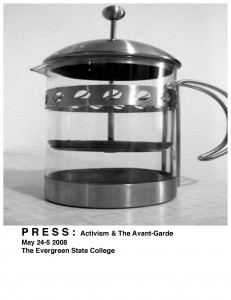Hello All,
David again. First, I want to remind you to attend, if at all possible, our first PRESS Event of the year: reading and discussion by Philadelphia Poet Debrah Morkun. Here is the flyer/announcement. Below it is the reading list. Readings THIS WEEK ONLY are DUE SATURDAY. Usually Saturdays will be for language lab/seminar, but because Weds will largely be logistical, we’ll reverse it this week. Lecture on the readings will be Saturday. If you can, get started, so that perhaps Wednesday we can begin just a tad on themes of the course, now with some other voices in our heads. Morkun, then the readings:
On behalf of Wheelhouse Magazine & Press, The Evergreen State College & its affiliated programs, I’m pleased to announce that our PRESS: Text Arts & Radical Politics Series kicks off with a visit and reading by poet, curator, and professor of writing, Debrah Morkun. Debrah’s visit will be followed soon after by Rachel Zolf (October). More on Zolf’s visit to come.
WHEN: Monday Sept 27, 7pm
WHERE: Sem II, B1105
Debrah Morkun’s first book of poem(s), Projection Machine, was released by BlazeVox Books in April 2010. She is a founding member of The New Philadelphia Poets, a group committed to keeping poetry alive in Philadelphia. She is currently at work on two long poem pieces entitled The Ida Pingala and Hera Calf. View some of her work at http://www.debrahmorkun.com/, and keep up to date with many of her happenings at www.newphiladelphiapoets.com
READINGS FOR SATURDAY:
1) “Docile Bodies,” by Michel Foucault (pdf sent via email)
2) Chapter 2 of Pedagogy of the Oppressed by Paulo Freire HERE
3) “1984″ by The Surveillance Camera Players (video) HERE
4) A How/Why Interview with The Surveillance Camera Players (video) HERE
5) “A I D /I/ S A P P E A R A N C E” by Joan Retallack below AND in pdf via email:
for Stefan Fitterman
for Stefan Fitterman
1. in contrast with the demand of continuity in the customary description
2. of nature the indivisibility of the quantum of action requires an essential
3. element of discontinuity especially apparent through the discussion of the
4. nature of light she said it’s so odd to be dying and laughed still it’s early
5. late the beauty of nature as the moon waxes turns to terror when it wanes
6. or during eclipse or when changing seasons change making certain things
7. disappear and there is no place to stand on and strangely we’re glad
A I D S
for tefn Fttermn
1. n contrt wth the emn of contnuty n the cutomry ecrpton
2. of nture the nvblty of the quntum of cton requre n eentl
3. element of contnuty epeclly pprent through the cuon of the
4. nture of lght he t o o t be yng n lughe tll t erly
5. lte the beuty of nture the moon wxe turn to terror when t wne
6. or urng eclpe or when chngng eon chnge mkng certn thng
7. pper n there no plce to tn on n trngely we’re gl
B H J C E R T
fo fn Fmn
1. n on w mn of onnuy n uomy pon
2. of nu nvly of qunum of on qu n nl
3. lmn of onnuy plly ppn oug uon of
4. nu of lg o o yng n lug ll ly
5. l uy of nu moon wx un o o wn wn
6. o ung lp o wn ngng on ng mkng n ng
7. pp n no pl o n on n ngly w gl
F G K Q U
o n mn
1. no n w m no on ny no my pon
2. o n nvly o nm o on n nl
3. lm no onny plly pp no on o
4. no l o o yn nl ll ly
5. l y o n moon wx no own wn
6. o n l pow n n no n n mn n n
7. pp n no pl o no n n nly w l
L P V
o n mn
1. no n w m no on ny no my on
2. o n ny o nm o on n n
3. m no onny y no on o
4. no o o y n n y
5. y o n moon wx no own wn
6. o now n n no n n mn n n
7. n no o no n n n y w
M O W
n
1. n n n n n y n y n
2. n n y n n n n
3. n n n y y n n
4. n y n n y
5. y n n x n n n
6. n n n n n n n n n
7. n n n n n n y
N X
1. y y
2. y
3. y y
4. y y
5. y
6.
7. y
Y
1.
2.
3.
4.
5.
6.
7.
Author’s Note: The disappearance moves through the letters of the alphabet (and the
source text) in this way: Beginning with letters A I D S, it spreads to adjoining letters B H J C
E R T, to F G K Q U, to L P V, to M O W, to N X, to Y. Part of the text in the first stanza is from
“The Atomic Theory and the Fundamental Principles underlying the Description of Nature”
in The Philosophical Writings of Niels Bohr, Volume 1, Atomic Theory and the Description of
Nature. Woodbridge, Connecticut, 1987


